A prehistoric axe hoard, a Renaissance teratoma, a long-lost giant dirk, and now Dr. Irving Finkel in full self-deprecating-cuneiform-genius charm mode? I think this week’s news is making up nicely for my having been sidelined by injury.
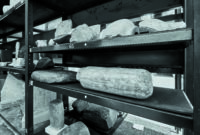 There’s a new display on right now at the British Museum dedicated to the world’s oldest recorded example of a protracted boundary dispute. As with most “oldest recorded examples” of historical events, business transactions and shopping lists, this was written in cuneiform script more than 4,000 years ago. Three artifacts tell the tale of a border conflict in Mesopotamia, now southern Iraq, featuring the neighboring city states of Lagash and Umma. Both of them claimed a strip called “Edge of the Plain,” and both of them of course claimed the gods were on their side in the conflict.
There’s a new display on right now at the British Museum dedicated to the world’s oldest recorded example of a protracted boundary dispute. As with most “oldest recorded examples” of historical events, business transactions and shopping lists, this was written in cuneiform script more than 4,000 years ago. Three artifacts tell the tale of a border conflict in Mesopotamia, now southern Iraq, featuring the neighboring city states of Lagash and Umma. Both of them claimed a strip called “Edge of the Plain,” and both of them of course claimed the gods were on their side in the conflict.
 The earliest artifact to give specifics on this fight is the Lagash Border Pillar, a white stone pillar inscribed by order of King Enmetena of Lagash in 2400 B.C. to mark the boundary line of his territorial claim. When it was installed in the desert, the stone would have reflected the light in brilliant white, catching the eye of any passersby. It is believed to be the earliest written description of a border dispute and is also the first recorded use of the term “no man’s land.”
The earliest artifact to give specifics on this fight is the Lagash Border Pillar, a white stone pillar inscribed by order of King Enmetena of Lagash in 2400 B.C. to mark the boundary line of his territorial claim. When it was installed in the desert, the stone would have reflected the light in brilliant white, catching the eye of any passersby. It is believed to be the earliest written description of a border dispute and is also the first recorded use of the term “no man’s land.”
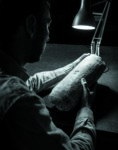 The pillar has been in the collection of the British Museum for 150 years, but in all that time the inscription has never been fully deciphered. It was dusted off just for the new show and Dr. Irving Finkel, incomparable cuneiform scholar, gamesman and raccounteur, deciphered the text. It is a full account of the border war between Lagash and Umma. The carver used the script to prop of his side and put down the enemy’s by using cuneiform symbol for “god” in the name of Lagash’s protector deity, Ningirsu, while the name of Umma’s god is written in such sloppy script it’s barely legible. That is shade, cuneiform-style.
The pillar has been in the collection of the British Museum for 150 years, but in all that time the inscription has never been fully deciphered. It was dusted off just for the new show and Dr. Irving Finkel, incomparable cuneiform scholar, gamesman and raccounteur, deciphered the text. It is a full account of the border war between Lagash and Umma. The carver used the script to prop of his side and put down the enemy’s by using cuneiform symbol for “god” in the name of Lagash’s protector deity, Ningirsu, while the name of Umma’s god is written in such sloppy script it’s barely legible. That is shade, cuneiform-style.
“You have in one breath the use of writing in a magical way to enhance the power of one deity and then nullify the power of the other. This is unique in cuneiform. It’s the most exciting thing you can imagine,” Finkel tells Pickford at The Financial Times.
Finkel believes the pillar was artificially aged by a scribe to improve Lagash’s historical claim to Gu’edina. It appears the scribe also used an archaic form of cuneiform to make the pillar seem older, which made the modern interpretation effort difficult.
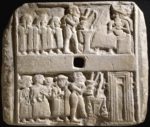 The Ur Plaque, also on display, is slightly older (ca. 2500 B.C.) but it’s not as direct a reference. It shows sacrificial offerings made at border shrines under the keen supervision of the Moon God, the type of rituals Lagash and Umma performed to enlist their deities’ support in boundary conflicts.
The Ur Plaque, also on display, is slightly older (ca. 2500 B.C.) but it’s not as direct a reference. It shows sacrificial offerings made at border shrines under the keen supervision of the Moon God, the type of rituals Lagash and Umma performed to enlist their deities’ support in boundary conflicts.
The third object in the trifecta is the Umma Mace-Head made for King Gishakidu of Umma, Enmetena’s counterpart and nemesis.
In a bit of serendipity, the curators realised during research for the show that an object they had long assumed was a vase had actually been displayed upside down. They now understand that it is actually the head of a fired-clay mace, or heavy club, made for King Gishakidu of Umma. After comparing the object with a similar one at Yale University, “we realised how daft we’d been”, says Irving Finkel, a co-curator of the show. Now displayed right-side up, the mace head is topped by a painted representation of a net that was used to immobilise enemies for execution.
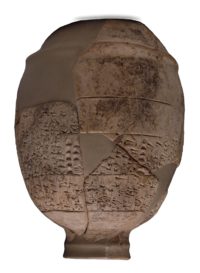
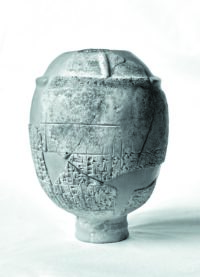
No Man’s Land is sponsored by the Asahi Shimbun and access to the display is free. It runs through Sunday, February 3rd, but if you’re in London, haul ass to the British Museum for your lunch break because Irving Finkel will be doing a gallery talk introducing the display at 1:15. No need to book a reservation. Just drop in and one of the world’s foremost experts in cuneiform will give you a little tour of a pillar, plaque and non-vase, no big deal.